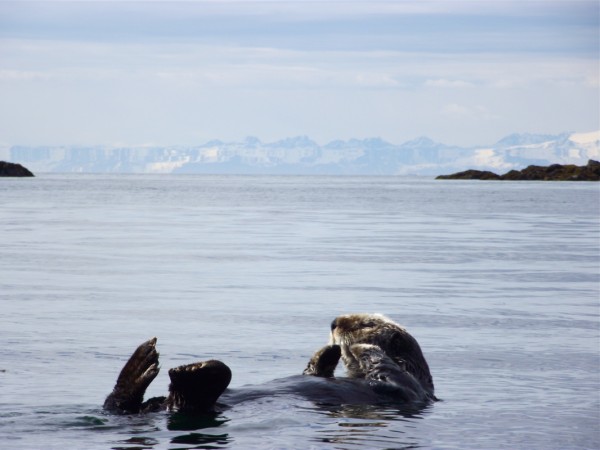What many Americans consider to be a cute, back-floating mammal is a pest, even a thief, to some Southeast Alaskan fishermen.

Humans and sea otters enjoy consuming the same bottom-dwelling seafood: Dungeness crabs, clams, sea cucumbers and urchins. Competition between dive fishermen and sea otters for those resources has intensified as the otter population grows.
Wadley has been a commercial sea cucumber diver for 27 years. She dove for abalone until the dive fishery closed in 1996.
“We had an abalone fishery here until the otters ate us out of it,” she said. “And then I switched about the time that the abalone fishery was dying, the sea cucumbers started up.”
A paper published by the U.S. Fish & Wildlife Service in 2014 says the sea otter population is growing by 12 to 14 percent a year. And more otters mean an expansion of their range.
Many sea cucumber, clam and urchin dive fishing areas have been closed to commercial fishing because of sea otters, Wadley said.
They eat immense amounts of seafood and seem to have the leading edge on humans.
It wasn’t easy starting out as a female fisherman, Wadley said. She was inexperienced — green but eager. A diver with a good reputation eventually agreed to take her out for abalone.
“I ended up getting more poundage than the rest of the divers put together,” she said.
Now Wadley owns her own 45-foot boat named “Vulcan.” She has a sea cucumber quota and manages her own personal dive fishing operation. Wadley and one other person take her boat out for seven-hour fishery openings.
She swims to the ocean bottom with four empty bags and a tank of oxygen on her back. Her partner waits on the boat. He will pull up the heavy bags packed with cucumbers.
“Boy, once you get underwater, I mean, it’s beautiful down there,” Wadley said.
But the last few times she went out, cucumbers were pretty “skinny.”
“When you get into an area where there are sea otters it looks like a World War II bombed out zone,” she said. “There’s dust everywhere. They do a lot of damage to the bottom.”
Wadley said sea otters like abalone best, so that fishery closed first. Next it was urchins, and then cucumbers. Geoduck clams are next, she said.
“They’re totally eating us out of house and home.”
The Southeast Alaska Regional Dive Fisheries Organization supports legislation to reduce sea otter numbers by incentivizing harvests by Alaska Natives.
Federal law prohibits hunting of marine mammals in American waters; Alaska Native subsistence hunters are exempt from the law.
According to U.S. Fish & Wildlife documents, 1,137 sea otters were harvested statewide this year.
In 2011 and 2013, bills were introduced by federal and state lawmakers to create incentives for Natives to hunt more sea otters. The proposed bills were supporting the declining commercial Dungeness crab and dive fisheries.
In 2013, state Sen. Bert Stedman, a Republican from Sitka (R-Sitka), introduced a bill proposing a $100 bounty for each sea otter harvested by an Alaska Native.
The bill did not pass.
Mike Miller, chair of the Indigenous People’s Council for Marine Mammals (IPCoMM), said that Natives were mostly opposed the bounty bill.
Miller, who lives in Sitka, said his group supports legislation that encourages economic opportunity for Native communities, but “the one thing we didn’t want to do was inadvertently to change from that goal to a predator control issue which is more just about getting rid of the animal.”
But Phil Doherty, director of the Southeast dive fisheries organization, said that Native subsistence and commercial fishing interests aligned.
“It is a win-win,” he said.
According to Doherty, the bill proposal was about “trying to help the Native hunters pay for some of their expenses.”
But Miller said that the enacted bill could have caused a flood in the market of sea otter pelts, which would drive their value down and ultimately harm Native communities.
Harriet Wadley said she doesn’t understand why the government prohibits hunting of sea otters by non-Natives.
“We control every other population: deer, bear, wolves. We keep every population in control and under balance,” she said. “Why is it because this creature is cute that we can’t maintain a balance and open up a hunting season on them?”
Wadley estimates the sea cucumber fishery has six years of life left if nothing is done about otters.
After that, she says she’ll be done diving.
Wadley said she doesn’t know what will come next. Maybe winter kings, or perhaps vacation.




